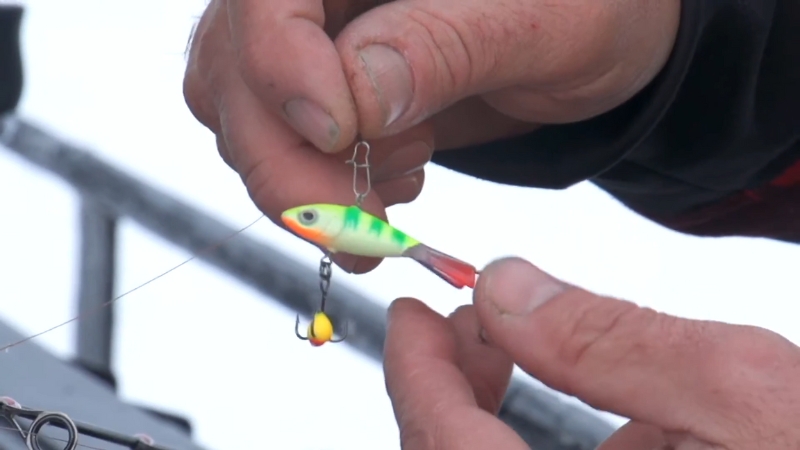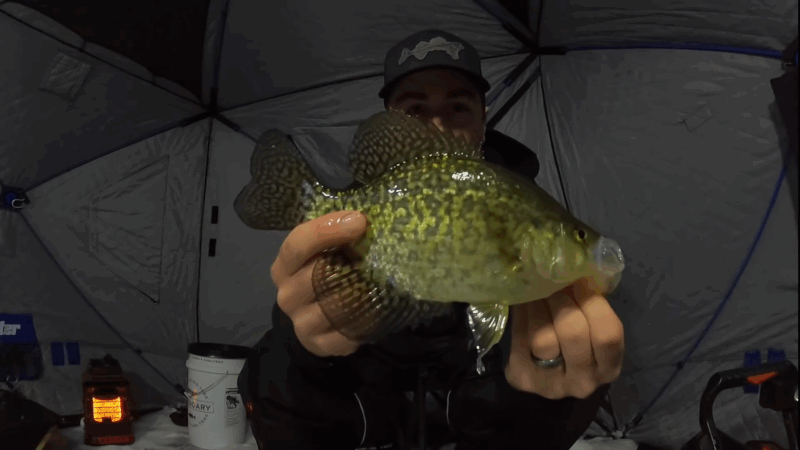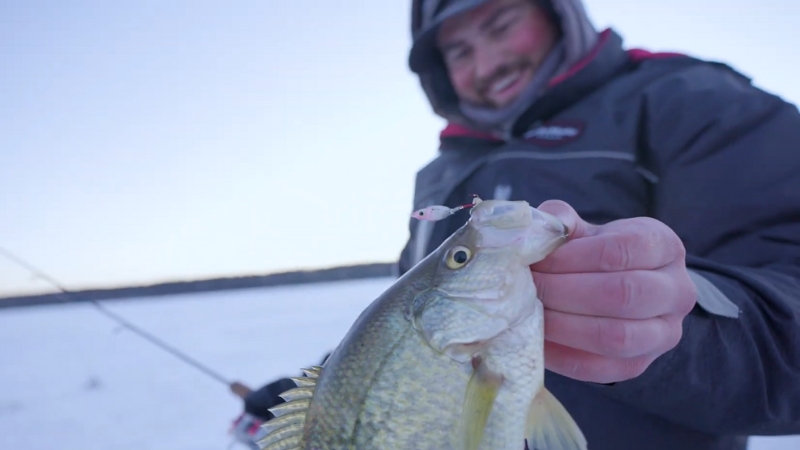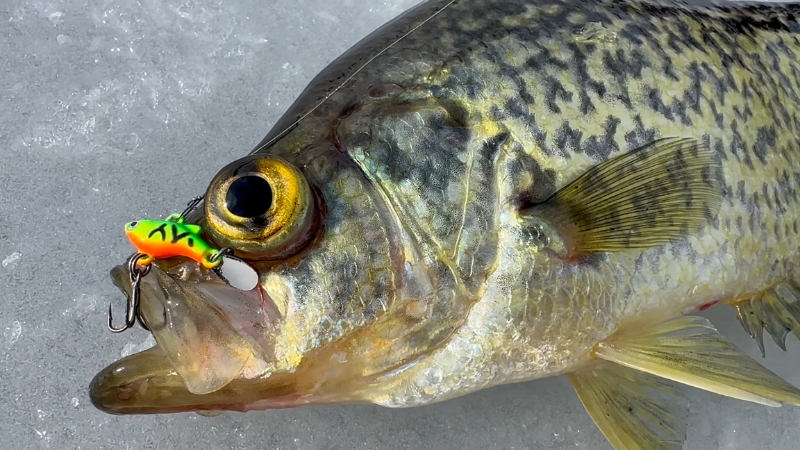You know the feeling. You’ve been hole-hopping, tweaking your jig cadence, switching out plastics, maybe even whispering to the fish gods — and then, bam, it happens.
Your flasher lights up like downtown at Christmas, and you’re surrounded by blinking crappie blips, high, low, mid-column. It’s a feeding frenzy, and for the next period, you’re living in pure, frosty bliss.
Most of the time, ice fishing for crappie is about finesse, timing, and picking the right bait for the situation. So let’s get into it. What works? When should you use it? And how can you consistently stack crappie on the ice?
Crappies aren’t always pushovers. Sure, they’ll hammer a jig one day, and ghost you the next.
What makes them so tricky and interesting is how selective they can be. They see well in low light, they feed up, and they don’t mess around when it comes to size or movement.
In short, they’re picky predators. Give them something that suggests food, not mimics it perfectly, and you’re in business. That might mean matching the size of zooplankton, tweaking color based on water clarity, or switching to a “call bait” when they’ve vanished from your flasher.
Timing plays a huge role, too. Dawn and dusk often trigger aggressive feeding, while midday might require subtle presentations and a little patience.
1. Lunkerhunt Spade Grub — The Workhorse Soft Plastic
View this post on Instagram
When to Use
Why It Works
The Lunkerhunt Spade Grub is one of those rare soft plastics that excels in finesse situations but can still call up curious crappies from a few feet below. Its magic lies in its straight, flat spear-like tail, molded to react to the tiniest movement.
Even if you’re not moving your rod tip much (or at all), the plastic flutters and trembles with ambient water movement or the slight pulse from your spring bobber.
Unlike curly tails or oversized paddle designs, the Spade Grub looks like something alive in the water, a tiny insect, a zooplankton, or a hatching larva. And that’s what finicky crappies are after.
The bait’s scent infusion helps seal the deal, keeping fish chewing longer and giving you more time to detect the bite and set the hook, especially important when the hits are gentle.
Technique Tips
- Drop it slow and let it settle slightly above the crappie marks on your flasher. These fish feed up, so positioning matters.
- Pause right in their face. Let the bait sit perfectly still. Watch the line for slack or subtle twitches.
- If you’re getting looks but no bites, add a micro shake, letting the tail flutter. It mimics a prey item, just barely trying to swim.
- If that fails, slowly start raising the jig. Many crappies can’t resist a lure that’s slowly escaping.
You can run it on anything from a size #12 to #8 jighead, but tungsten is preferred; it keeps your bait horizontal and delivers more feel through the rod.
Best Colors
Water Clarity
Go-To Color
Clear
White
Stained
Chartreuse
Pressured/Tough
Pumpkin
The pumpkin color might look muted, but on high-pressure days, it can be the most natural and effective tone in your arsenal.
2. VMC Tungsten Wax Tail Jig — Speed Meets Subtlety
When to Use
Why It Works
The VMC Tungsten Wax Tail Jig is a great mix of speed, weight, and finesse.
Tungsten drops like a rock, faster than lead, which means less time waiting and more time in front of active fish. This is clutch when you’re sitting on a brief bite window or chasing a moving school.
What sets the Wax Tail Jig apart is the pre-rigged TriggerX tail, designed to mimic tiny aquatic insects, the kind crappies feast on all winter.
The bait’s soft appendages move with minimal effort, adding lifelike motion even when your rod tip is still. That subtle “quiver” is perfect for neutral fish.
You also get a bonus with the glow options. Pre-charged under a headlamp or LED, the jig glows up to 15 minutes per drop, making it ideal for those low-light bite periods when fish tend to rise off the bottom.
Technique Tips
- Start with a quick vertical drop to the middle or upper third of the water column — crappies often suspend higher than you’d expect.
- Give it short hops, then pause 3–5 seconds between movements. Fish often eat on the pause, not during the motion.
- When fish are tight-lipped, try a “hover and twitch” technique. Keep the jig stationary and lightly flick the line with your index finger.
- Use a fluoro leader (2-4 lb) to maintain a more natural fall and better bite detection.
Best Sizes & Depth Pairings
Jig Weight
Depth Range
Fish Behavior
1/32 oz.
8–12 ft
Neutral, finicky
1/16 oz.
12–25+ ft
Aggressive or deep suspended fish
Color Considerations
Light Conditions
Recommended Colors
Bright midday
UV Pink, Natural White
Cloudy/Dusk
Glow Chartreuse, Glow Red
Night Fishing
Glow Blue, Glow Orange
Remember to recharge the jig every few drops for best performance after dark.
3. Custom Jigs & Spins Rotating Power Minnow (RPM) — The Secret Weapon

When to Use
Why It Works
The RPM isn’t your typical drop-and-soak ice bait. It’s more like a hardwater crankbait, designed to draw fish in with erratic, swimming action. Crappies are sight predators with a weak spot for struggling prey.
Its unique design features a swivel eyelet, which eliminates line twist (a common issue with swimming lures).
That means better bait control and less time untangling knots.
The lack of a nose hook also prevents hangups in the ice hole, a subtle feature that makes a big difference, especially when fish are right below the hole or when you’re using a transducer.
It also comes with a colorful epoxy belly treble hook featuring an attractor “eye,” which gives off just enough visual interest to trigger reaction bites, even from hesitant fish.
Technique Tips
- Use short, sharp snaps of the rod tip to make the bait dart side to side, like a wounded minnow.
- Pause often — many crappies inhale the bait on the fall or still moments between snaps.
- On days when the fish are lazy, switch to micro-jiggles or a slow lift-drop to keep it in their zone longer.
- Add a wax worm or minnow head to the treble only if fish are inspecting but not committing. In many cases, the bait works best clean.
Gear Suggestions
Line Type
Benefits
Light braid (5-8 lb) + 4 lb fluoro leader
Max sensitivity and zero stretch
Straight 3-4 lb mono
Simpler, decent action control
The RPM’s ¼ oz. Weight gives you control, even on windy days or deep spots. You’ll feel the action right through the blank of a sensitive graphite rod.
Best Scenarios for Color Selection
Water Conditions
Top Colors
Clear Lake
Perch, Silver Shiner
Stained or Murky
Firetiger, Glow Orange, Red Craw
Early/Late Light
Glow Pink, Electric Chicken
Night Bite Crappies

Here’s where things can get wild.
On certain lakes, once the sun dips, big crappies just go nuts. They rise in the column, get way less cautious, and start flying up to crush baits.
On one small lake we used to fish, the bite kicked off right after dark and stayed fire-hot for an hour. You didn’t need minnows. You didn’t even need to tip your jig. Just drop, jig, lift, repeat.
Top Tips for Night Fishing
During that golden hour, go a bit bigger — like a Puppet Minnow or RPM — and let the fish come to you. Don’t be surprised when they shoot up ten feet to grab it.
Livebait: Still Has a Place (Sometimes)
Let’s not toss livebait entirely in the slush bucket. Some days, usually post-front, or when fish are in a funk, nothing beats a small crappie minnow under a slip bobber or lightly worked on a plain hook.
Other times, waxies or spikes can tempt neutral fish when even plastics get ignored.
But when fish are moving fast and feeding hard, bait can slow you down. Plastics are faster, cleaner, and way more efficient when you’re hopping holes and covering water.
Ice Rod Setup and Line Matters, Too
@mattjohnsonoutdoors Ice fishing for crappies… doesn’t get much better than that!! Especially when they’re crushing the Tikka Flash!! Quick rundown on how I fish this amazing lure 👊 #icefishing #icefish #clamoutdoors #tikka #tikkaflash #crappie #crappiefishing #slab #onice #winter #iceteam #panfish @Clam Outdoors ♬ original sound – Matt Johnson
Don’t overlook your setup. Even the best bait under the ice can fall flat without the right rod, line, and cadence.
Ideal Setup for Most Situations
One Last Thing
The most effective ice anglers adjust constantly. They don’t just tie on a bait and wait — they watch, test, experiment. If the school’s reacting but not committing, try:
Watch the fish on your sonar like it’s a video game. If they chase but stop short, that’s not a rejection — it’s feedback. Try again, differently.
Wrap Up

Finding a school of winter crappies is one thing. Getting them to commit, over and over again, is the real trick. The right bait can make all the difference, but only if you match it to the mood of the fish.
Crappies primarily feed on small minnows, insects, and even tiny crustaceans, so selecting baits that mimic their natural prey is key.
Use “call baits” to locate and activate a school. Follow up with micro plastics or soft-tipped tungsten jigs when things slow down. And always, always keep experimenting.
Because the next time your screen lights up like a disco ball, you’ll want the kind of bait that doesn’t just catch fish, it catches them right now.
What bait’s been your winter MVP so far this season?

